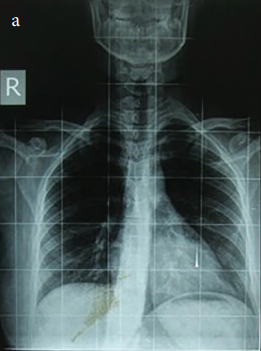Objective: The aim of this study was to evaluate the clinical outcomes and the coronal correction rate of the main and accompanying curves of adolescent idiopathic scoliosis (AIS) corrected with pedicle screws inserted consecutively or intermittently.
Methods: The prospectively collected data of 60 patients (8 men and 52 women; mean age: 14.6±2.5 years) who underwent corrective surgery for AIS between January 2010 and December 2015 were reviewed retrospectively. Two groups were constituted according to the pedicle screw construct type: consecutive pedicle screw construct (CPSC) and intermittent pedicle screw construct (IPSC) groups. The preoperative, early postoperative, and 24-month follow-up radiographs and the Scoliosis Research Society-22 (SRS-22) scores were reevaluated. The Cobb angle of the main and accompanying curves, the correction rate, and the flexibility of the curves were calculated.
Results: The mean preoperative Cobb angles were 57.03° and 57.46°, the mean postoperative Cobb angles were 14.93° and 14.4°, and the mean correction rates were 76.22% and 75.31% in IPSC and CPSC groups, respectively (p>0.05). The preoperative and postoperative accompanying curve magnitudes and correction rates were similar (p>0.05). These radiographic outcomes were also consistent with the SRS-22 scores.
Conclusion: Both the pedicle screw constructs had satisfactory outcomes following the surgery, which were confirmed by both the SRS-22 scores and radiographs taken perioperatively and at follow-ups. The IPSC and CPSC groups did not demonstrate a significant change in the correction rate of the main and minor or major accompanying structural and nonstructural curves, and also in the SRS-22 scores.
Level of Evidence: Level III, Retrospective comparative study
Cite this article as: Şenköylü A, Çetinkaya M, Daldal İ, Eren A, Aktaş E. The implant density does not change the correction rate of the main and the accompanying curves: A comparison between consecutive and intermittent pedicle screw constructs. Acta Orthop Traumatol Turc 2020; 54(3): 293-9. DOI: 10.5152/j.aott.2020.03.16.



.png)
.png)

